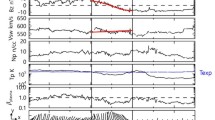Abstract
Based on the magnetospheric kinetic theory, a model is developed to specify the flux of energetic electrons in the inner and middle magnetosphere. Under the assumption of adiabatic motion and isotropic particle distribution maintained by pitch-angle scattering, the model calculates the electron flux by following bounce-averaged electric field, gradient, and curvature drift in the time dependent electric and magnetic field, meanwhile it counts the electron loss caused by pitch angle scattering. Using the model, the electron flux distribution during a magnetic storm was calculated and compared with the observation data from the geosynchronous orbit. It is shown that the model can successfully reproduce most of the major electron flux enhancements observed at the geosynchronous orbit and generally tracks the satellite data well. The rms errors of the modeled logarithm of flux are between 0.5–1.0.
Similar content being viewed by others
References
Heinemann M. Role of collisionless heat flux in magnetospheric convection. J Geophys Res, 1999, 104: 28397
Heineman M, Wolf R A. Relationships of models for the inner magnetosphere to the Rice Convection Model. J Geophys Res, 2001, 106: 15545
Harel M, Wolf R A, Reiff P H, et al. Quantitative simulation of a magnetospheric substorm 1, model logic and overview. J Geophys Res, 1981, 86: 2217–2241
Wolf R A. The quasi-static (slow-flow) region of the magnetosphere. In: Carovillano R L, Forbes J M, eds. Solar-Terrestrial Physics. D Riedel, 1983. 303–368
De Zeeuw D L, Sazykin S, Wolf R A, et al. Coupling of a global MHD code and an inner magnetospheric model: Initial results. J Geophys Res, 2004, 109, A12219, doi:10.1029/2003JA010366
Freeman J W, Wolf R A, Spiro R W, et al. Development of a magne-tospheric specification model. AD-A244 460, 1991
Volland H. A model of the magnetospheric electric convection field. J Geophys Res, 1978, 83: 2695
Heppner J P, Maynard N C, Rich F J. Heppner-Maynard-Rich electric field model. Planet Space Sci, 1992, 40: 551–552
Tsyganenko N A. A magnetospheric magnetic field model with a warped tail current sheet. Planet Space Sci, 1989, 27: 5–20
Vasyliunas V M. A survey of low-energy electrons in the evening sector of the magnetosphere with OGO 1 and OGO 3. J Geophys Res, 1968, 73: 2839–2884
Vette J L. The AE-8 trapped electron model environment. Goddard Spaceflight Center. NSSDC Publication, 1991. 91–24
Garrett H B, Schwenk D C, Deforest S E. A statistical analysis of the low-energy geosynchronous plasma environment -1 electrons. Planet Space Sci, 1981, 29: 1021–1044
Huang C Y, Frank L A. A statistical study of the central plasma sheet. Geophys Res Lett, 1986, 13: 652–655
Baker D N, Stauning P, Hones E W, et al. Strong electron pitch angle diffusion observed at geostationary orbit. Geophys Res Lett, 1979, 6: 205–208
Xiao F, Zong Q G, Chen L. Pitch-angle distribution evolution of energetic electrons in the inner radiation belt and slot region during the 2003 Halloween storm. J Geophys Res, 2009, 114: A01215, doi: 10.1029/2008JA013068
Schumaker T L, Gussenhoven M S, Hardy D A, et al. The relationship between diffuse auroral and plasma sheet electron distributions near local midnight. J Geophys Res, 1989, 10061–10078
Lyons L R, Thorne R M, Kennel C F. Pitch angle diffusion of radiation belt electrons within the plasmasphere. J Geophys Res, 1972, 77: 3455
Lambour R L. Calibration of the Magnetospheric Specification and Forecast Model for the Inner Magnetosphere. Texas: Rice University, Houston, 1994
Hilmer R V, Voigt G H. A magnetospheric magnetic field model with flexible current systems driven by independent physical parameters. J Geophys Res, 1995, 100: 5613–5626
Li X, Baker D N, Temerin M, et al. Energetic electrons, 50 keV to 6 MeV, at geosynchronous orbit: Their responses to solar wind variations. Space Weather, 2005, 3: S04001, doi: 10.1029/2004SW000105
Xiao F, Su Z, Zheng H, et al. Three-dimensional simulations of outer radiation belt electron dynamics including cross-diffusion terms. J Geophys Res, 2010, 115: A05216, doi: 10.1029/2009JA014541
Author information
Authors and Affiliations
Corresponding author
Rights and permissions
About this article
Cite this article
Li, L., Feng, Y. Energetic electron flux distribution model in the inner and middle magnetosphere. Sci. China Technol. Sci. 54, 441–446 (2011). https://doi.org/10.1007/s11431-010-4234-7
Received:
Accepted:
Published:
Issue Date:
DOI: https://doi.org/10.1007/s11431-010-4234-7



